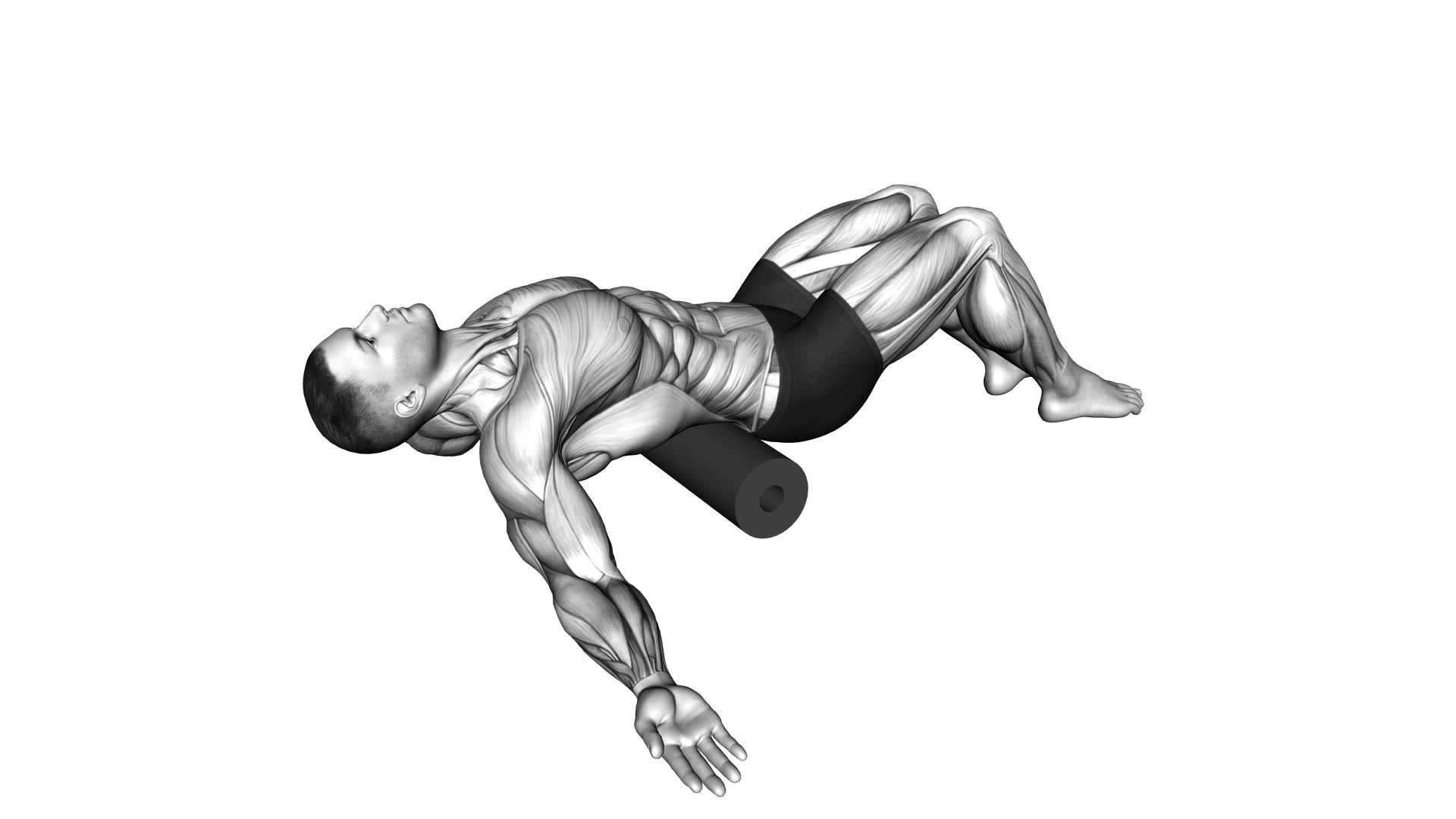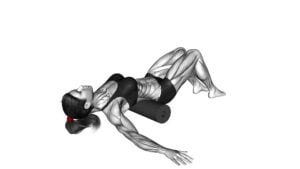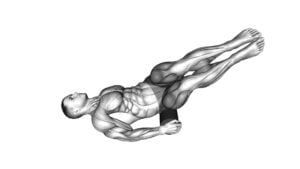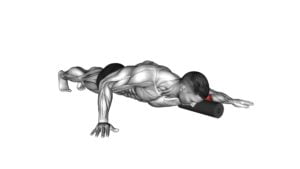Roll Erector Spinae Lying on Floor – Video Exercise Guide & Tips

Are you looking for an effective exercise to target your erector spinae muscles? Look no further!
Watch This Exercise Video
In this video exercise guide, we'll show you how to perform the Roll Erector Spinae lying on the floor.
You'll discover the benefits of this exercise, the equipment you'll need, and the correct form and technique to maximize your results.
Whether you're a beginner or looking to progress, we've got you covered with modifications, common mistakes to avoid, and tips for variation.
Let's get started!
Key Takeaways
- The Roll Erector Spinae exercise strengthens back muscles and improves core stability.
- Proper body alignment and positioning are important for effective targeting of the erector spinae muscles and to minimize the risk of injury.
- Modifications for beginners include using a foam roller for support, starting with a smaller foam roller for stability, and reducing the range of motion.
- Common mistakes to avoid include rounding the back, straining the neck, losing proper alignment, not engaging the core, and using momentum instead of muscle strength.
Benefits of the Roll Erector Spinae Exercise
The Roll Erector Spinae exercise offers three key benefits for strengthening your back muscles. This exercise is a great addition to your functional fitness routine, as it targets the erector spinae muscles, which are responsible for maintaining proper posture and supporting the spine.
Firstly, the Roll Erector Spinae exercise helps to improve back strength. By engaging the erector spinae muscles, this exercise helps to build endurance and stability in your back. This is important for everyday activities such as lifting heavy objects and maintaining good posture throughout the day.
Secondly, this exercise also helps to improve core stability. As you perform the Roll Erector Spinae exercise, you'll engage your core muscles to maintain balance and control. This not only strengthens your core, but also helps to improve overall body stability and coordination.
Lastly, the Roll Erector Spinae exercise can also help to alleviate back pain. By strengthening the back muscles, this exercise can help to reduce strain on the spine and provide support for the surrounding structures. This can be particularly beneficial for individuals who experience chronic back pain or have a history of back injuries.
Incorporating the Roll Erector Spinae exercise into your fitness routine can provide significant benefits for your back strength and overall functional fitness.
Equipment Needed for the Exercise
To perform the Roll Erector Spinae exercise, you'll need a mat or a comfortable surface to lie on. Having the right equipment is crucial to ensure proper execution and maximize the benefits of the exercise. Here are the types of equipment you can use and their advantages:
- Exercise mat: A mat provides cushioning and support for your body, making it more comfortable to perform the exercise. It also helps prevent any discomfort or strain on your back or joints.
- Resistance band: Adding a resistance band can increase the intensity of the exercise and help you build strength in your erector spinae muscles. The band provides resistance throughout the movement, making your muscles work harder.
- Stability ball: Using a stability ball can challenge your balance and stability, engaging more muscles in your core and back. It also allows for a greater range of motion, enabling you to activate your erector spinae muscles more effectively.
Proper Form and Technique
To ensure proper execution and maximize the benefits of the Roll Erector Spinae exercise, it's important to maintain a specific form and technique. Proper form is crucial to prevent injury and engage the target muscles effectively. One common mistake is arching the back excessively, which can strain the lower back. To avoid this, keep your core engaged and maintain a neutral spine throughout the exercise.
Another mistake is using momentum to roll up and down, rather than relying on the strength of the erector spinae muscles. Slow and controlled movements are key to effectively target and strengthen these muscles.
Breathing techniques are also important during the Roll Erector Spinae exercise. It's essential to inhale deeply before starting the movement and exhale as you roll up and contract the erector spinae muscles. This helps to engage the core and stabilize the spine. Remember to maintain a steady breathing pattern throughout the exercise to optimize your performance.
Modifications for Beginners
If you're a beginner, don't worry! There are modifications available for the Roll Erector Spinae exercise that will make it more beginner-friendly.
These modifications simplify the exercise variations, making it easier for you to perform while still targeting the erector spinae muscles effectively.
Beginner-Friendly Modifications
Start by using a foam roller to support your back while lying on the floor. This modification is perfect for beginners who may need extra support during the exercise.
Here are three beginner-friendly modifications and alternative exercises to try:
- Use a smaller foam roller: If the standard foam roller feels too challenging, start with a smaller one. This will provide more stability and make the exercise more manageable for beginners.
- Perform the exercise on a mat: If using a foam roller is still too difficult, try doing the exercise on a mat instead. This will provide some cushioning and make it easier to maintain proper form.
- Reduce the range of motion: If you find it hard to fully roll up and down, start by performing smaller movements. Gradually increase the range of motion as you build strength and confidence.
Simplified Exercise Variations
You can simplify the exercise variations for beginners by gradually increasing the range of motion as you build strength and confidence.
Start by performing the Roll Erector Spinae lying on the floor with a smaller range of motion. Instead of rolling all the way up to a seated position, focus on engaging your core and lifting your upper body slightly off the floor. This modified version will still target your erector spinae muscles while providing a more accessible variation for beginners.
As you become more comfortable and stronger, you can gradually increase the range of motion by rolling higher and eventually reaching a full seated position. By starting with these beginner-friendly variations, you can ensure proper form and reduce the risk of injury.
Now let's discuss some common mistakes to avoid.
Common Mistakes to Avoid
To ensure proper form, make sure to keep your spine aligned and your shoulders relaxed throughout the exercise.
Position yourself on the floor with your feet flat and your knees bent.
Remember to engage your core and breathe deeply to maintain stability and control throughout the movement.
Proper Form Tips
To ensure proper form and avoid common mistakes, it's important to focus on maintaining a neutral spine while performing the Roll Erector Spinae exercise lying on the floor. Here are some tips to help you maintain proper form:
- Avoid rounding your back: Keep your spine in a neutral position throughout the exercise. This will help engage the erector spinae muscles effectively.
- Use your breath: Inhale as you prepare for the movement and exhale as you roll up, engaging your core muscles. This will provide stability and support during the exercise.
- Don't strain your neck: Keep your neck relaxed and in line with your spine. Avoid tucking your chin or looking up towards the ceiling.
By following these tips, you can ensure proper form and maximize the benefits of the Roll Erector Spinae exercise.
Now, let's move on to discuss alignment and positioning for this exercise.
Alignment and Positioning
Maintaining proper alignment and positioning is crucial for avoiding common mistakes while performing the Roll Erector Spinae exercise lying on the floor. Proper body alignment ensures that you engage the correct muscles and prevent strain or injury.
Start by lying flat on your back with your knees bent and feet flat on the floor. Align your hips, shoulders, and head in a straight line. Avoid arching your back or lifting your hips off the floor. Keep your neck relaxed and avoid straining or tensing it.
Correct positioning is essential for targeting the erector spinae muscles effectively. By maintaining proper body alignment and correct positioning, you can maximize the benefits of the exercise while minimizing the risk of injury.
Breathing Techniques for Stability
To ensure stability and avoid common mistakes, focus on your breathing techniques while performing the Roll Erector Spinae exercise lying on the floor. Proper breathing can enhance core stability and maximize the effectiveness of this exercise. Here are three key breathing techniques to keep in mind:
- Diaphragmatic breathing: Breathe deeply into your diaphragm, allowing your belly to rise as you inhale and fall as you exhale. This type of breathing promotes relaxation and optimal engagement of your core muscles.
- Exhale during exertion: Coordinate your breath with the movement of the exercise. Exhale as you roll up and engage your erector spinae muscles, and inhale as you lower back down.
- Maintain a steady rhythm: Establish a consistent breathing pattern throughout the exercise to maintain stability and control.
Tips for Progression and Variation
How can you enhance your Roll Erector Spinae exercise on the floor? To progress and add variety to your routine, here are some tips for progression options and advanced variations.
Firstly, you can increase the difficulty by adding weights. By holding a dumbbell or a weighted plate against your chest while performing the exercise, you engage your erector spinae muscles even more, leading to greater strength gains.
Another way to progress is by incorporating instability. You can use a stability ball or a foam roller to challenge your core stability and improve your balance. Place the stability ball or foam roller under your torso while performing the exercise to create an unstable surface, forcing your muscles to work harder to maintain proper alignment.
Additionally, you can try performing the exercise on an incline or decline surface. By adjusting the angle, you target different parts of your erector spinae muscles, providing a more comprehensive workout.
Lastly, you can explore advanced variations such as the single-leg roll erector spinae exercise. By lifting one leg off the ground while performing the exercise, you increase the demand on your core stability and enhance the activation of your erector spinae muscles.
Remember to progress gradually and listen to your body. Always maintain proper form and consult with a fitness professional if you have any concerns or questions.
Frequently Asked Questions
How Many Sets and Repetitions Should Be Performed for the Roll Erector Spinae Exercise?
To determine how many sets and repetitions you should perform for the roll erector spinae exercise, it's important to consider your fitness level and goals.
Start with 2-3 sets of 10-12 repetitions and gradually increase as you get stronger.
Remember to listen to your body and adjust the intensity accordingly.
Consulting with a fitness professional can also provide personalized guidance for optimal results.
Can the Roll Erector Spinae Exercise Be Done by Individuals With Lower Back Pain?
Yes, the roll erector spinae exercise can be modified for individuals with lower back pain. By using a foam roller or a rolled-up towel placed under the lower back for support, you can reduce strain on the lower back while still targeting the erector spinae muscles.
Incorporating this exercise into your daily fitness routine can help improve posture, strengthen the back muscles, and alleviate lower back pain over time.
Is It Necessary to Warm up Before Performing the Roll Erector Spinae Exercise?
Before performing the roll erector spinae exercise, it's important for you to warm up properly.
Warming up has many benefits, such as increasing blood flow to your muscles, loosening up your joints, and preparing your body for the upcoming exercise.
To warm up effectively, you can start with some light cardio exercises like jogging or jumping jacks, followed by dynamic stretches that target the muscles you'll be using during the exercise.
Are There Any Specific Breathing Techniques That Should Be Followed During the Exercise?
During the roll erector spinae exercise, it's important to focus on your breathing techniques. By inhaling deeply through your nose and exhaling fully through your mouth, you can help engage your core and support your lower back.
This will also promote better stability and control throughout the exercise. If you have lower back pain, modifications can be made to accommodate your needs and ensure a safe and effective workout.
Can the Roll Erector Spinae Exercise Be Included in a Full-Body Workout Routine?
Including the roll erector spinae exercise in your full-body workout routine can offer numerous benefits. This exercise targets your erector spinae muscles, which play a crucial role in maintaining proper posture and spinal stability. By strengthening these muscles, you can improve your overall core strength and reduce the risk of back pain.
If you're looking for alternatives to the roll erector spinae exercise, consider exercises like deadlifts or supermans, which also engage the erector spinae muscles.
Conclusion
In conclusion, the roll erector spinae exercise is an effective way to strengthen and stretch the muscles in your back.
By performing this exercise properly and consistently, you can improve your posture, alleviate back pain, and enhance your overall back strength and flexibility.
Remember to start with proper form and technique and gradually increase the difficulty level as you progress.
With dedication and focus, you can reap the benefits of this exercise for a healthier and stronger back.

Author
Years ago, the spark of my life’s passion ignited in my mind the moment I stepped into the local gym for the first time. The inaugural bead of perspiration, the initial endeavor, the very first surge of endorphins, and a sense of pride that washed over me post-workout marked the beginning of my deep-seated interest in strength sports, fitness, and sports nutrition. This very curiosity blossomed rapidly into a profound fascination, propelling me to earn a Master’s degree in Physical Education from the Academy of Physical Education in Krakow, followed by a Sports Manager diploma from the Jagiellonian University. My journey of growth led me to gain more specialized qualifications, such as being a certified personal trainer with a focus on sports dietetics, a lifeguard, and an instructor for wellness and corrective gymnastics. Theoretical knowledge paired seamlessly with practical experience, reinforcing my belief that the transformation of individuals under my guidance was also a reflection of my personal growth. This belief holds true even today. Each day, I strive to push the boundaries and explore new realms. These realms gently elevate me to greater heights. The unique combination of passion for my field and the continuous quest for growth fuels my drive to break new ground.







